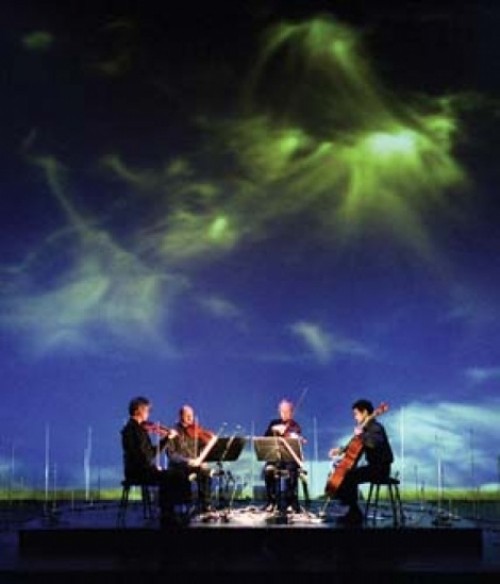A&E | Cosmic Thing: Kronos Quartet turns the sounds of space into a multimedia exploration.
By Jacob Stringer“It really is that simple,” says Kronos Quartet’s David Harrington. “Space brings out the child in each one of us. Everyone has looked up and wondered, ‘What’s going on? Where are we? What is this?’ And it’s thrilling for a bunch of adults to be able to do just that.”
nSuch was the impetus behind Kronos Quartet’s spectacle Sun Rings, an evening-length work written for the genre-bending string quartet by their long time collaborator, Terry Riley. The production, which includes a fascinating multimedia dimension, got started when Kronos received a call from NASA—specifically the government agency’s arts program director, Burt Ulrich.
n“Burt’s question to Kronos was, ‘Would we be interested in including some of the sounds recorded on the Voyager expeditions in our concerts?’” recalls Harrington. “My first thought was I didn’t know there were any sounds out there. So, of course, I got very curious.
n“Within a short time, I received a tape from NASA, and what struck me initially is that they didn’t sound like other parts of nature that I’ve heard, such as insects, sea mammals, birds and all kinds of sounds. But it did still sound like a part of nature to me, and I became very intrigued.”
nSoon after that first call in 2000, Riley was brought on board, and he began to collect more and more of the audio tapes from NASA’s archives. In his listening, he noticed melodies within these strange sounds. Many of these melodies became the foundation upon which he structured Sun Rings.
nUnfortunately—shortly after the piece really began to ferment; he actually started to compose in August of 2001—the world came crashing down. The tragic events of 9/11 silenced him for quite a while. By the time he began writing again, he took a completely different tack.
n“I got a call from [Riley] saying, ‘I think this piece is going to need a large choir,’” says Harrington. “The choir itself is always a fantastic experience, because whenever we do the piece, we get to work with a local choir. We’ve performed this in Moscow, South Korea, England and Germany, and one of the things that I love about this piece is that no matter where you are, you get a sense of the community through the participating choir. When you get all those new people as part of the team, something happens. It becomes this kind of community piece. It’s really unlike anything else we play.”
nBut adding a choir simply wasn’t enough. According to Harrington, Riley phoned again a couple of weeks later and said that—in addition to the choir—the piece was going to need a visual component as well. Enter Willie Williams, who has worked with the likes of U2 and REM. The reason he came to mind is that Kronos’ manager had seen a U2 concert staged by Williams, and he was utterly amazed at how Williams was able to make something as large as an arena ultimately feel so intimate.
n“If anything needed his magic, it was Sun Rings,” says Harrington. “So, we got in touch with Willie, and it turns out that he has been interested in cosmology ever since he was a little kid and just jumped at the opportunity of being a part of this.”
nSo pretty quickly, before Kronos even had a solid grasp of what Riley was truly composing, Sun Rings became a monumental production. The multidimensions introduced by the participation of the choir, the staging and the visual elements are what brought more and more people into the orbit of the project. Improbably, the team was formed in a haphazard way, and they never even had a director; everybody just took care of his or her own little part.
nThat kind of energetic assembling of the piece was an important part of how Sun Rings developed in that chaotic post-tragedy world. It was only those events of 9/11 that made Riley take pause, when he didn’t want simply to invite the audience to look outward into space, pondering humanity from that earthbound position. He wanted to invite the audience to imagine itself out in space, looking back to it has here on Earth.
n“That reversal of perception is done very subtly in this piece,” says Harrington. “What I like about Sun Rings is that it is a 90-minute opportunity for people to think about where we are and what we are. So it is a very meditative piece. It is an opportunity to reflect on our place and our role here. It is a great opportunity to think.”
n nKronos Quartet: Sun Rings Featuring the University of Utah Singers
nKingsbury Hall, 1395 E. Presidents Circle, 581-7100
nThursday, Nov. 13 @ 7:30 p.m.
nKingTix.org
More by Jacob Stringer
-
Slamdance 2014
After two decades, Slamdance is experienced in turning failure into fortune
- Jan 16, 2014
-
2013 Utah Beer Festival by The City Weekly Store
- Aug 20, 2013
-
Twilight Concert Series (7.18.13)
- Jul 24, 2013
- More »
Latest in Arts & Entertainment
Readers also liked…
-
New TV for January 2023
Mayfair Witches, Velma, The Last of Us, Poker Face and more premieres
- Jan 4, 2023



